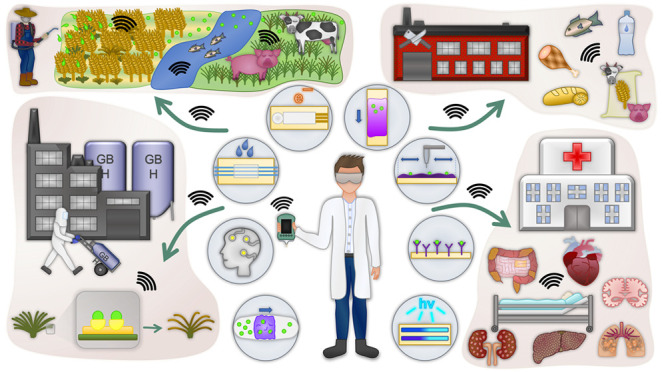- Record: found
- Abstract: found
- Article: found
Glyphosate Separating and Sensing for Precision Agriculture and Environmental Protection in the Era of Smart Materials

Read this article at
Abstract

The present article critically and comprehensively reviews the most recent reports on smart sensors for determining glyphosate (GLP), an active agent of GLP-based herbicides (GBHs) traditionally used in agriculture over the past decades. Commercialized in 1974, GBHs have now reached 350 million hectares of crops in over 140 countries with an annual turnover of 11 billion USD worldwide. However, rolling exploitation of GLP and GBHs in the last decades has led to environmental pollution, animal intoxication, bacterial resistance, and sustained occupational exposure of the herbicide of farm and companies’ workers. Intoxication with these herbicides dysregulates the microbiome-gut-brain axis, cholinergic neurotransmission, and endocrine system, causing paralytic ileus, hyperkalemia, oliguria, pulmonary edema, and cardiogenic shock. Precision agriculture, i.e., an (information technology)-enhanced approach to crop management, including a site-specific determination of agrochemicals, derives from the benefits of smart materials (SMs), data science, and nanosensors. Those typically feature fluorescent molecularly imprinted polymers or immunochemical aptamer artificial receptors integrated with electrochemical transducers. Fabricated as portable or wearable lab-on-chips, smartphones, and soft robotics and connected with SM-based devices that provide machine learning algorithms and online databases, they integrate, process, analyze, and interpret massive amounts of spatiotemporal data in a user-friendly and decision-making manner. Exploited for the ultrasensitive determination of toxins, including GLP, they will become practical tools in farmlands and point-of-care testing. Expectedly, smart sensors can be used for personalized diagnostics, real-time water, food, soil, and air quality monitoring, site-specific herbicide management, and crop control.
Related collections
Most cited references247
- Record: found
- Abstract: found
- Article: not found
Deep learning.
- Record: found
- Abstract: found
- Article: not found
Global food demand and the sustainable intensification of agriculture.
- Record: found
- Abstract: not found
- Article: not found